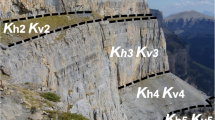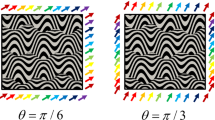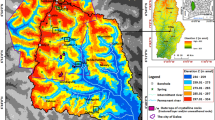Abstract
Weathering and compression are important processes that influence how permeability varies with depth below the Earth’s surface. Analysis of permeability measurements suggests that the rapid permeability decrease in shallow crystalline bedrock to a depth of ~200 m is primarily a function of weathering, and that compression causes a steady reduction in permeability with depth. The depth of the base of weathering increases with rock dissolution rate, and varies from ~20 m in shale to sometimes >1,000 m in carbonate rocks.
Résumé
L'altération et la compression sont des processus importants qui influencent la façon dont la perméabilité varie en fonction de la profondeur sous la surface de la Terre. L’analyse des mesures de perméabilité suggère que la diminution rapide de la perméabilité dans un substrat rocheux cristallin peu profond jusqu’à une profondeur d’environ 200 m est principalement liée à l’altération, et que la compression provoque une réduction constante de la perméabilité avec la profondeur. La profondeur de la partie inférieure de l’horizon d’altération augmente avec le taux de dissolution des roches, et varie d’environ 20 m dans les schistes à parfois plus de 1000m dans les roches carbonatées.
Resumen
La meteorización y la compactación son procesos importantes que influyen en la variación de la permeabilidad con la profundidad bajo la superficie terrestre. El análisis de las mediciones de permeabilidad sugiere que la rápida disminución de la permeabilidad en el basamento rocoso poco profundo hasta una profundidad de ~200 m es principalmente una función de la meteorización, y que la compactación provoca una reducción constante de la permeabilidad con la profundidad. La profundidad de la base de meteorización aumenta con la velocidad de disolución de la roca, y varía desde ~20 m en esquistos hasta a veces >1000 m en rocas carbonáticas.
摘要
风化和压缩是影响渗透性随地球地表深度变化的重要过程。渗透性测量分析表明,浅层结晶基岩中渗透性在约200 m深度内快速下降,主要是由于风化作用,而压缩则导致渗透性随深度逐渐减少。风化基底的深度随着岩石溶解速率的增加而增加,在页岩中约为20 m,而在碳酸盐岩中有时超过1000 m。
Resumo
O intemperismo e a compressão são processos importantes que influenciam a forma como a permeabilidade varia com a profundidade abaixo da superfície da Terra. A análise das medições de permeabilidade sugere que a rápida diminuição da permeabilidade em rochas cristalinas rasas até uma profundidade de ~200 m é principalmente uma função do intemperismo, e que a compressão causa uma redução constante na permeabilidade com a profundidade. A profundidade da base do intemperismo aumenta com a taxa de dissolução da rocha, e varia de ~20 m em xistos até às vezes >1000 m em rochas carbonáticas.

Similar content being viewed by others
References
Achtziger-Zupančič P, Loew S, Mariéthoz G (2017) A new global database to improve prediction of permeability distribution in crystalline rocks at site scale. J Geophys Res: Solid Earth 122:3513–3539
Anderson SP (2019) Breaking it down: mechanical processes in the weathering engine. Elements 15(4):247–252
Anderson RN, Zoback MD, Hickman SH, Newmark RL (1985) Permeability versus depth in the upper oceanic crust: in situ measurements in DSDP hole 504B, eastern equatorial Pacific. J Geophys Res: Solid Earth 90(B5):3659–3669
Anderson SP, Dietrich WE, Brimhall GH Jr (2002) Weathering profiles, mass-balance analysis, and rates of solute loss: linkages between weathering and erosion in a small, steep catchment. Geol Soc Amer Bull 114(9):1143–1158
Ascott MJ, Mansour MM, Bloomfield JP, Upton KA (2019) Analysis of the impact of hydraulic properties and climate change on estimations of borehole yields. J Hydrol 577:123998
Berner EK, Berner RA (2012) Global environment. Princeton University Press, Princeton, NJ
Berner RA, Morse JW (1974) Dissolution kinetics of calcium carbonate in sea water, IV: theory of calcite dissolution. Amer J Sci 274(2):108–134
Bianchi M, Palamakumbura RN, MacDonald AM, Macdonald DM (2023) Assessing regional variation in yield from weathered basement aquifers in West Africa and modelling their future groundwater development and sustainability. Hydrogeol J 31(2):257–274
Brantley SL, Holleran ME, ** L, Bazilevskaya E (2013) Probing deep weathering in the Shale Hills Critical Zone Observatory, Pennsylvania (USA): the hypothesis of nested chemical reaction fronts in the subsurface. Earth Surf Process Landf 38:1280–1298
Buckley DK (2000) Some case histories of geophysical downhole logging to examine borehole site and regional groundwater movement in Celtic regions. Geol Soc London Spec Publ 182:219–237
Burger P (2024) World deep caves. https://cave-exploring.com/index.php/long-and-deep-caves-of-the-world/world-deep-caves/. Accessed 18 Jan 2024
Burns ER, Williams CF, Ingebritsen SE, Voss CI, Spane FA, DeAngelo J (2015) Understanding heat and groundwater flow through continental flood basalt provinces: insights gained from alternative models of permeability/depth relationships for the Columbia Plateau, United States. Geofluids 15:120–138
Cardenas MB, Jiang XW (2010) Groundwater flow, transport, and residence times through topography‐driven basins with exponentially decreasing permeability and porosity. Water Resour Res 46(11). https://doi.org/10.1029/2010WR009370
Carter PG, Mills DAC (1976) Engineering geological investigations for the Kielder Tunnels. Q J Eng Geol Hydrogeol 9(2):125–141
Chandler RJ (1974) Lias clay: the long-term stability of cutting slopes. Géotechnique 24(1):21–38
Comte JC, Cassidy R, Nitsche J, Ofterdinger U, Pilatova K, Flynn R (2012) The typology of Irish hard-rock aquifers based on an integrated hydrogeological and geophysical approach. Hydrogeol J 20(8):1569–1588
Davis SN, Turk LJ (1964) Optimum depth of wells in crystalline rocks. Ground Water 2(2):6–11
De Waele J, Gutiérrez F (2022) Karst hydrogeology, geomorphology and caves. Wiley, Chichester, NJ
Dewandel B, Lachassagne P, Wyns R, Maréchal JC, Krishnamurthy NS (2006) A generalized 3-D geological and hydrogeological conceptual model of granite aquifers controlled by single or multiphase weathering. J Hydrol 330(1–2):260–284
Dreybrodt W (1990) The role of dissolution kinetics in the development of karst aquifers in limestone: a model simulation of karst evolution. J Geol 98(5):639–655
Dutton SP, Diggs TN (1992) Evolution of porosity and permeability in the lower Cretaceous Travis Peak Formation, East Texas. AAPG Bull 76(2):252–269
Einsele G, Sauter M, Clemens T, Boehme M, Poppe R (1995) Carbonate dissolution along fractures of sandstone aquifers: field observations and modelling. IAHS Publ. vol 225. IAHS, Wallingford, UK, pp 71–78
Ford DC, Williams PW (2007) Karst hydrogeology and geomorphology. Wiley, Chichester, NJ
Gleeson T, Smith L, Moosdorf N, Hartmann J, Dürr HH, Manning AH, van Beek LPH, Jellinek AM (2011) Map** permeability over the surface of the Earth. Geophys Res Lett 38(2):L02401
Green JA, Runkel AC, Alexander EC Jr (2012) Karst conduit flow in the Cambrian St. Lawrence Confining Unit, southeast Minnesota, USA. Carbon Evapor 27:167–172
Gu X, Rempe DM, Dietrich WE, West AJ, Lin TC, ** L, Brantley SL (2020) Chemical reactions, porosity, and microfracturing in shale during weathering: the effect of erosion rate. Geochim Cosmochim Acta 269:63–100
Hahm WJ, Rempe DM, Dralle DN, Dawson TE, Lovill SM, Bryk AB, Bish DL, Schieber J, Dietrich WE (2019) Lithologically controlled subsurface critical zone thickness and water storage capacity determine regional plant community composition. Water Resour Res 55(4):3028–3055
Hartmann J, Dürr HH, Moosdorf N, Meybeck M, Kempe S (2012) The geochemical composition of the terrestrial surface (without soils) and comparison with the upper continental crust. Int J Earth Sci 101:365–376
Holbrook WS, Marcon V, Bacon AR, Brantley SL, Carr BJ, Flinchum BA, Richter DD, Riebe CS (2019) Links between physical and chemical weathering inferred from a 65-m-deep borehole through Earth’s critical zone. Sci Rep 9:4495
Ingebritsen S, Gleeson T (2017) Crustal permeability. Hydrogeol J 25(8):2221–2224
Ingebritsen SE, Manning CE (2010) Permeability of the continental crust: dynamic variations inferred from seismicity and metamorphism. Geofluids 10(1–2):193–205
Ingebritsen SE, Sanford WE, Neuzil C (2006) Groundwater in geologic processes. Cambridge University Press, Cambridge, UK
Jackson TR, Fenelon JM (2022) Relation of hydraulic conductivity to depth, alteration, and rock type in the volcanic rocks of Pahute Mesa, Nevada, USA. Hydrogeol J 30(8):2417–2432
Jiang XW, Wan L, Wang XS, Ge S, Liu J (2009) Effect of exponential decay in hydraulic conductivity with depth on regional groundwater flow. Geophys Res Lett 36(24)
Jiang XW, Wang XS, Wan L (2010) Semi-empirical equations for the systematic decrease in permeability with depth in porous and fractured media. Hydrogeol J 18(4):839–850
Kaufmann G, Romanov D (2019) The initial phase of cave formation: aquifer-scale three-dimensional models with strong exchange flow. J Hydrol 572:528–542
Kuang X, Jiao JJ (2014) An integrated permeability-depth model for Earth’s crust. Geophys Res Lett 41(21):7539–7545
Lachassagne P, Wyns R, Dewandel B (2011) The fracture permeability of hard rock aquifers is due neither to tectonics, nor to unloading, but to weathering processes. Terra Nova 23(3):145–161
Lachassagne P, Aunay B, Frissant N, Guilbert M, Malard A (2014) High-resolution conceptual hydrogeological model of complex basaltic volcanic islands: a Mayotte, Comoros, case study. Terra Nova 26(4):307–321
Lachassagne P, Dewandel B, Wyns R (2021) Hydrogeology of weathered crystalline/hard-rock aquifers—guidelines for the operational survey and management of their groundwater resources. Hydrogeol J 29(8):2561–2594
LeGrand HF, Stringfield VT (1971) Development and distribution of permeability in carbonate aquifers. Water Resour Res 7(5):1284–1294
Liao R, Gu X, Brantley SL (2022) Weathering of chlorite from grain to watershed: the role and distribution of oxidation reactions in the subsurface. Geochim Cosmochim Acta 333:284–307
Liedl R, Sauter M, Hückinghaus D, Clemens T, Teutsch G (2003) Simulation of the development of karst aquifers using a coupled continuum pipe flow model. Water Resour Res 39(3):1057. https://doi.org/10.1029/2001WR001206
Louis C (1972) Rock hydraulics. In: Müller L (ed) Rock mechanics. Springer, Vienna, pp 299–387
Manning CE, Ingebritsen SE (1999) Permeability of the continental crust: implications of geothermal data and metamorphic systems. Rev Geophys 37(1):127–150
Medici G, West LJ, Mountney NP (2018) Characterization of a fluvial aquifer at a range of depths and scales: the Triassic St Bees Sandstone Formation, Cumbria, UK. Hydrogeol J 26(2):565–591
Medici G, West LJ, Mountney NP, Welch M (2019) Permeability of rock discontinuities and faults in the Triassic Sherwood Sandstone Group (UK): insights for management of fluvio-aeolian aquifers worldwide. Hydrogeol J 27(8):2835–55
Meinzer OE (1923) The occurrence of ground water in the United States. US Geol Surv Water Suppl Pap, pp 489. https://doi.org/10.3133/wsp489
Palmer AN (1991) Origin and morphology of limestone caves. Geol Soc Am Bull 103(1):1–21
Parker BL, Chapman SW, Goldstein KJ, Cherry JA (2019) Multiple lines of field evidence to inform fracture network connectivity at a shale site contaminated with dense non-aqueous phase liquids. Geol Soc Lond Spec Publ 479:101–127
Pedrazas MA, Hahm WJ, Huang MH, Dralle D, Nelson MD, Breunig RE, Fauria KE, Bryk AB, Dietrich WE, Rempe DM (2021) The relationship between topography, bedrock weathering, and water storage across a sequence of ridges and valleys. J Geophys Res: Earth Surf 126(4):2020JF005848
Pradhan RM, Singh A, Ojha AK, Biswal TK (2022) Structural controls on bedrock weathering in crystalline basement terranes and its implications on groundwater resources. Sci Rep 12:11815
Ranjram M, Gleeson T, Luijendijk E (2015) Is the permeability of crystalline rock in the shallow crust related to depth, lithology or tectonic setting? Geofluids 15:106–119
Romanov D, Gabrovsek F, Dreybrodt W (2003) The impact of hydrochemical boundary conditions on the evolution of limestone karst aquifers. J Hydrol 276:240–253
Runkel AC, Tip** RG, Steenberg JR, Retzler AJ, Meyer JR, Parker BL, Green JA, Barry JD, Jones PM (2018) A multidisciplinary-based conceptual model of a fractured sedimentary bedrock aquitard: improved prediction of aquitard integrity. Hydrogeol J 26(7):2133–2159
Rushton KR, Chan YK (1976) Pum** test analysis when parameters vary with depth. Ground Water 14(2):82–87
Rushton KR, Connorton BJ, Tomlinson LM (1989) Estimation of the groundwater resources of the Berkshire Downs supported by mathematical modeling. Q J Eng Geol Hydrogeol 22(4):329–41
Saar MO, Manga M (2004) Depth dependence of permeability in the Oregon Cascades inferred from hydrogeologic, thermal, seismic, and magmatic modeling constraints. J Geophys Res: Solid Earth 109(B4). https://doi.org/10.1029/2003JB002855
Shand P, Edmunds WM, Lawrence AR, Smedley PL, Burke S (2007) The natural (baseline) quality of groundwater in England and Wales. British Geol Surv Res Rep RR/07/06, BGS, Keyworth, UK
Sharp JM, Green RT, Schindel GM (2019) The Edwards Aquifer: the past, present and future of a vital water resource. Geol Soc Am Mem 215. https://doi.org/10.1130/MEM215
Shube H, Kebede S (2024) Variation in hydraulic structure with respect to depth and age of a large igneous province in Ethiopia. Hydrogeol J 32(1):97–108
Toccalino PL, Norman JE, Hitt KJ (2010) Quality of source water from public-supply wells in the United States, 1993-2007. US Geol Surv Sci Invest Rep 2010-5024
Tuttle MLW, Breit GN (2009) Weathering of the New Albany Shale, Kentucky, USA: I. weathering zones defined by mineralogy and major-element composition. Appl Geochem 24:1549–1564
Tye AM, Lawley RL, Ellis MA, Rawlins BG (2011) The spatial variation of weathering and soil depth across a Triassic sandstone outcrop. Earth Surf Process Landf 36(5):569–581
White AF, Brantley SL (2003) The effect of time on the weathering of silicate minerals: why do weathering rates differ in the laboratory and field? Chem Geol 202(3–4):479–506
Williams CF, Narasimhan TN (1989) Hydrogeologic constraints on heat flow along the San Andreas Fault: a testing of hypotheses. Earth Planet Sci Lett 92(2):131–143
Williams PW (1983) The role of the subcutaneous zone in karst hydrology. J Hydrol 61:45–67
Worthington SRH (2001) Depth of conduit flow in unconfined carbonate aquifers. Geology 29(4):335–338
Worthington SRH (2009) Diagnostic hydrogeologic characteristics of a karst aquifer (Kentucky, USA). Hydrogeol J 17(7):1665–1678
Worthington SRH (2021) Factors affecting the variation of permeability with depth in carbonate aquifers. Hydrogeol J 29(1):21–32
Worthington SRH (2023) Examining the assumptions of the single-porosity archetype for transport in bedrock aquifers. Hydrogeol J 31(1):87–96
Worthington SRH, Foley AE (2023) Development of spatial permeability variations in English Chalk aquifers. Geol Soc Lond Spec Publ 517:63–74
Worthington SRH, Ford DC (2009) Self-organized permeability in carbonate aquifers. Ground Water 47(3):326–336
Worthington SRH, Smart CC, Ruland W (2012) Effective porosity of a carbonate aquifer with bacterial contamination: Walkerton, Ontario, Canada. J Hydrol 464:517–527
Worthington SRH, Davies GJ, Alexander EC Jr (2016) Enhancement of bedrock permeability by weathering. Earth-Sci Rev 160:188–202
Wray RA, Sauro F (2017) An updated global review of solutional weathering processes and forms in quartz sandstones and quartzites. Earth-Sci Rev 171:520–557
Acknowledgements
Thanks go to reviewers Patrick Lachassagne and Jean-Christophe Comte for their perceptive comments on the manuscript. The author states that there is no conflict of interest.
Author information
Authors and Affiliations
Corresponding author
Additional information
Publisher’s Note
Springer Nature remains neutral with regard to jurisdictional claims in published maps and institutional affiliations.
Rights and permissions
Springer Nature or its licensor (e.g. a society or other partner) holds exclusive rights to this article under a publishing agreement with the author(s) or other rightsholder(s); author self-archiving of the accepted manuscript version of this article is solely governed by the terms of such publishing agreement and applicable law.
About this article
Cite this article
Worthington, S.R.H. Impact of weathering on permeability-depth trends in bedrock aquifers. Hydrogeol J (2024). https://doi.org/10.1007/s10040-024-02803-0
Received:
Accepted:
Published:
DOI: https://doi.org/10.1007/s10040-024-02803-0




